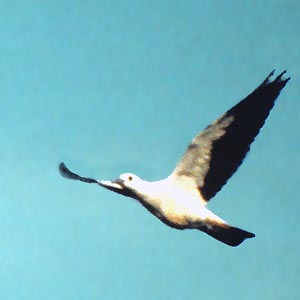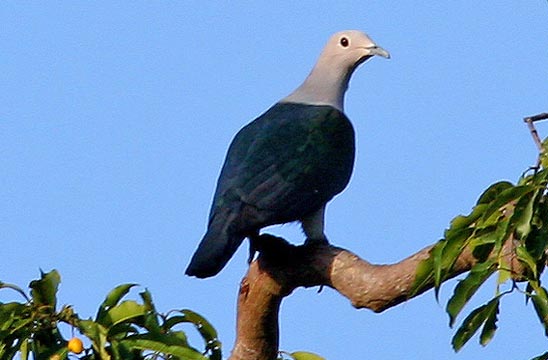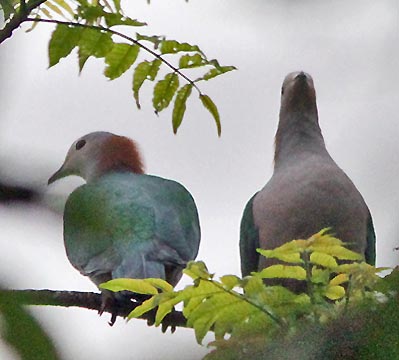
a web page by Don Roberson |

PIGEONS & DOVES Columbidae |
||||
|
||||
 Pigeons
and doves form a large, easily-recognized family of worldwide
distribution. Some thrive in huge dense flocks, as with the peripatetic
Flock Bronzewing in the interior of Australia (above). These recall the flocks of millions of Passenger Pigeon Ectopistes migratorius
that once darkened the skies of eastern North America, but are now
extinct due to over-hunting and habitat destruction. Others are mostly
solitary denizen of remote forests, such as the critically endangered Pink Pigeon
of Mauritius (left), now the subject of a captive breeding and
reintroduction project. Mauritius was once the home of the famed Dodo,
a giant flightless pigeon that was extinct by 1681. Pigeons
and doves form a large, easily-recognized family of worldwide
distribution. Some thrive in huge dense flocks, as with the peripatetic
Flock Bronzewing in the interior of Australia (above). These recall the flocks of millions of Passenger Pigeon Ectopistes migratorius
that once darkened the skies of eastern North America, but are now
extinct due to over-hunting and habitat destruction. Others are mostly
solitary denizen of remote forests, such as the critically endangered Pink Pigeon
of Mauritius (left), now the subject of a captive breeding and
reintroduction project. Mauritius was once the home of the famed Dodo,
a giant flightless pigeon that was extinct by 1681. |
||||
Others are common and widespread open country species. Two examples follow. First is a young Mourning Dove from North America, interrupted while bathing in a shallow river. It can be aged as a juvenal-plumaged bird by the crisp white edges the upperwing coverts. Below that is a common and widespread Old World species: Laughing Dove. It ranges from India and the Middle East down throughout open-country Africa. This adult is sun-bathing. |
||||
 |
||||
 |
||||
In
his monograph on the Columbidae, Goodwin (1970, 1983) recognized five
subfamilies of pigeons and doves. Baptista et al. (1997) used these to
organize their Handbook of the Birds of the World account.
Modern molecular techniques were not then available, but much of
Goodwin's work has survived rather well into the modern era of DNA
sequencing. Two of Goodwin's five subfamilies were single-species
groups that have now proven to be subsumed within larger groups,
leaving essentially three subfamilies. The most recent review of the family with DNA techniques is Pereira et al. (2007), and they found three major clades. Two of these more or less match Goodwin — a "Columbinae" group of "typical pigeons and doves" and a huge set of most of the tropical pigeons — but the third is unexpected. It is a small clade consists of 16 species in 4 genera of New World ground-doves. Most of these are Neotropical but a few breed in the southern United States. Another — Ruddy Ground-Dove —is a widespread Central American species that is a vagrant to the U.S. This shot of Ruddy Ground-Dove (right) is of a vagrant in Death Valley, California. The current evidence appears to indicate that the ancestor of these ground-doves was the earliest columbid to evolve, at least in the New World. The "Columbinae" group — Pereira et al. (2007) declined to formally revise the phylogeny of this family until additional data were available — has been studied a lot. Johnson et al. (2001) undertook a detailed molecular review of the genera Columba and Streptopelia. They found that the New World "Columba" were not closely related to the Old World Columba, and thus assigned a new genus to the New World pigeons: Patagioenas. The widespread Band-tailed Pigeon (below left) is in that new genus. It is found in forests from western North America all the way down the spine of Central America to the Andes. This leaves Columba for Old World species such as Hill Pigeon of eastern Asia (below right). |
||||
|
||||
For decades the abundant city columbid was called "Rock Dove;" recently it was officially renamed Rock Pigeon, consistent with the rest of the Columba pigeons. So some ask "what is the difference between a pigeon and a dove?" There really is no scientific answer. Rather, the smaller and paler columbids tend to be called "doves" while the larger, heavier, and darker columbids are traditionally called "pigeons." The common Rock Pigeon is intermediate in size, and can qualify as either a dove or a pigeon. In the tropics, as we shall see, the small colorful ones are often called "fruit-doves" while the large, heavy ones may be called "imperial-pigeons" or "mountain-pigeons." |
||||
 Another columbid whose range has dramatically spread around the world is Eurasian Collared-Dove
(right) — the species finally reached my backyard in pine woodland of
California. One of the "collared-doves" or "turtle-doves" in genus Streptopelia
in the Old World — known for the prominent neck markings — this
species' range has expanded dramatically. Original native to India, it
expanded into Turkey and the Balkans in the 16th century. Finding an
open niche in towns and cultivated land, it spread throughout Europe in
the 1940s and 1950s. In Britain, 4 birds in 1955 had become 19,000 by
1964. A dove-breeder apparently released 50 birds in the Bahamas in the
early 1970s, and they were discovered in Florida in the lat 1980s,
apparently having immigrated from the Bahamas. They then spread
throughout much of the Caribbean while, at the same time, began
colonizing the southern U.S.; all summarized in Romagosa & McEneary
(1999). They have now occurred throughout the U.S. and southern Canada.
Birds were known to be released in southern California in 1992. From
various release points, these have spread statewide. The first on the
Monterey Peninsula was in 2000. This one reached my backyard in Pacific
Grove in June 2010. A resident population now breeds in my town. Another columbid whose range has dramatically spread around the world is Eurasian Collared-Dove
(right) — the species finally reached my backyard in pine woodland of
California. One of the "collared-doves" or "turtle-doves" in genus Streptopelia
in the Old World — known for the prominent neck markings — this
species' range has expanded dramatically. Original native to India, it
expanded into Turkey and the Balkans in the 16th century. Finding an
open niche in towns and cultivated land, it spread throughout Europe in
the 1940s and 1950s. In Britain, 4 birds in 1955 had become 19,000 by
1964. A dove-breeder apparently released 50 birds in the Bahamas in the
early 1970s, and they were discovered in Florida in the lat 1980s,
apparently having immigrated from the Bahamas. They then spread
throughout much of the Caribbean while, at the same time, began
colonizing the southern U.S.; all summarized in Romagosa & McEneary
(1999). They have now occurred throughout the U.S. and southern Canada.
Birds were known to be released in southern California in 1992. From
various release points, these have spread statewide. The first on the
Monterey Peninsula was in 2000. This one reached my backyard in Pacific
Grove in June 2010. A resident population now breeds in my town. |
||||
| Johnson et al. (2001) reviewed the relationships of the 16 species of Streptopelia, and found that there were 3 evolutionary clades. They found that most were in a group of African and Asian collared and/or turtle-doves, but that the endangered Pink Pigeon Nesoenas mayeri of Mauritius was in another clade, along with Madagascar Turtle-Dove S. picturata. Laughing Dove was in the third clade along with Spotted Dove S. chinensis of eastern Eurasia. There are two ways of looking at this evidence, and that is just now being sorted out. One can lump then all — including Pink Pigeon — in one large Streptopelia assemblage, or one can assign Madagascar Turtle-Dove to Nesoenas (with Pink Pigeon), and then put Laughing and Spotted Doves in genus Spilopelia. The latter two species lack the "excitement cry" that is so typical of the "usual" Streptopelia doves (Baptista et al. 1997). I prefer that arrangement. | ||||
|
||||
|
||||
|
||||
The monotypic Tooth-billed Pigeon Didunculus strigirostris of Samoa and the large Pheasant Pigeon Otidiphaps nobilis of lowland and foothill forests in New Guinea are also within the same set of related ground-dwellers. Among the large "Clade C" in Pereira et al. (2007) are three other large subclades with many species of Old World pigeons. One of these has just discussed, with Dodo and crowned-pigeons. Each subclade might be considered a subfamily — rather similar to Goodwin's subfamilies. The one that Goodwin did not anticipate, and is thus newly considered a distinctive set of columbids, contains a number of genera from southeast Asia to Australasia, and most of them are ground-dwellers. Sixteen species were once assigned to genus Gallicolumba, but a recent phylogeny shows that genus to be polyphyletic as then constituted; Jønsson et al. (2011). Nine ground-doves from New Guinea and the Solomons that are distributed north to oceanic islands as far as Micronesia are now assigned to genus Alopecoenas. Of necessity, this colonization required over-ocean flights of up to 1100 km, which seems quite amazing. Some of these are now considered endangered, including Caroline Ground-Dove (below), which occurs only on Chuuk (Truk) and Pohnpei in the eastern Caroline Islands. |
||||
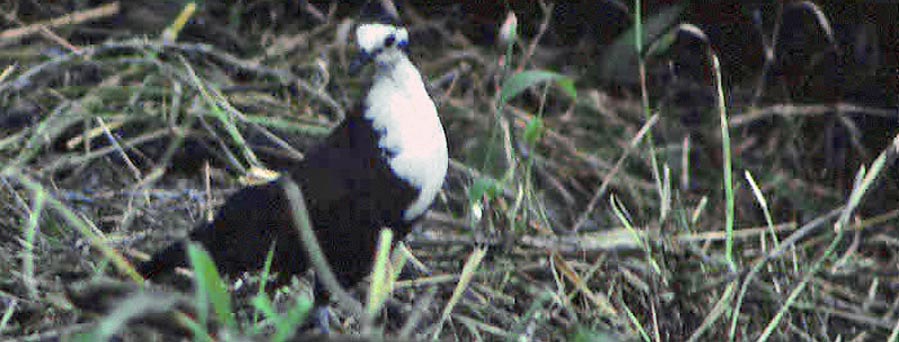 |
||||
|
||||
 |
||||
Spinifex Pigeon (right) is as dramatic as the red-rock habitat in which it lives. Common Bronzewing (below left) prefers open woodlands, such as eucalypt woods, but is also at home in mulga or mallee. Wonga Pigeon (below right) prefers the understory of dense rainforest. |
||||
|
||||
Africa has genera in this groups as well. The lovely and dramatic Namaqua Dove is a bird of thornscrub veldt in eastern and southern Africa. This is a female (left) from Kenya. The black-faced male (below) is shown at a Kalahari waterhole that also has a visiting Ring-necked Dove, sometimes called "Cape Turtle-Dove." Yet another small radiation is composed of the green pigeons (genus Treron) and assorted offshoots. Green-pigeons occur in both African and southern Asia. |
||||
 |
||||
|
||||
 |
||||
It took flash photography to obtain a shot of Red-eared Fruit-Dove (above) in the pre-dawn darkness in montane Sulawesi. It also took flash to observe this nesting White-bibbed Fruit-Dove in the Wandammen Mts. of New Guinea (right, a fine shot by Will Betz). White-bibbed Fruit-Dove has five subspecies, some with all-white "bibs" and other, like this one of race bellus, with a bright yellow crescent within the "bib." |
||||
|
||||
|
||||
|
||||
Photos: The dense flight of Flock Bronzewing Psophia crepitans was along the Birdsville Track, South Australia, 0n 20 Nov 2009. The Pink Pigeon Nesoenas mayeri was on Mauritius in Dec 1992. Murray Lord photographed the Orange Dove Ptilinopus victor on Fiji in March 2008. The juv Mourning Dove Zenaida macrura was bathing in the Carmel River, California, on 9 Sep 1991. The sunbathing Laughing Dove Streptopelia senegalensis was at Ma'agan Michael, Israel, on 18 Oct 1981. The Ruddy Ground-Dove Columbina talpacoti was at Furnace Creek, Death Valley NP, CA, USA, on 23 Oct 1988. The Band-tailed Pigeon Patagioenas fasciata was in my yard at Pacific Grove, Monterey Co., CA, USA, on 18 Feb 2006. The Hill Pigeon Columba rupestris was at Bao Qo, Xining, China, on 16 June 2004. The non-native Rock Pigeon Columba livia was at Seaside, Monterey Co., Calif., USA, on 18 Feb 2005. The non-native Eurasian Collared-Dove Streptopelia decaocto was at my Pacific Grove yard on 9 June 2010. The Slender-billed Cuckoo-Dove Macropygia amboinensis and the White-faced Cuckoo-Dove Reinwardtoena manadensis were at Tambon, Sulawesi, on 3 Oct 2011. The Ruddy Pigeon Patagioenas subvinacea was at Savegre, Costa Rica, on 22 Dec 2007. Greg W. Lasley photographed the White-tipped Dove Leptotila verreauxi at San Isidro, Texas, USA, on 2 Sep 1995. Simon Woolley & Julia Casson obtained the photo of Southern Crowned-Pigeon Goura sheepmakeri at Kiunga, Papua New Guinea, in July 2009. The sketch and skeleton of the Dodo Raphus cucullatus are from Wikipedia. The Caroline Ground-Dove Alopecoenas kubaryi was was on Moen I., Chuuk, Micronesia, on 30 Aug 1978. The two shots of Mindoro Bleeding-Heart Gallicolumba platenae were taken at Sablayan, Mindoro, Philippines, on 8 Dec 2005. The Diamond Dove Geopelia cuneata was along the Birdsville Track, South Australia, on 21 Nov 2009. The Spinifex Pigeon Geophaps plumifera was at Ormiston Pound, Northern Territories, Australia, on 17 Aug 2008. The Common Bronzewing Phaps chalcoptera was near Hobart, Tasmania, on 21 Aug 2008. The Wonga Pigeon Leucosarcia melanoleuca was in Lamington NP, Queensland, Australia, in Nov 1983. The female Namaqua Dove Oena capensis was at Samburu NP, Kenya, in Nov 1981, and the male Namaqua Dove with Ring-necked Dove Streptopelia capicola were at Kalahari NP, South Africa, in July 2005. The Seychelles Blue-Pigeon Alectroenas pulcherrima was on Fregate I., the Seychelles, on 11 Nov 1992. The Amethyst Dove Phapiteron amethystina was at Rajah Sikatuna NP, Bohol, Philippines, in Dec 2005. The Red-eared Fruit-Dove Ptilinopus fischeri as along the Anaso track, Lore Lindu NP, Sulawesi, Indonesia, on 28 Sep 2011. Will Betz photographed the nesting White-bibbed Fruit-Dove Ptilinopus rivoli bellus in the Wandammen Mts., Irian Jaya, Indonesia, in Oct 1997. The Spectacled Imperial-Pigeon Ducula perspicillata was at Foli, Halmahera, Indonesia, in Oct 2011. The Pied Imperial-Pigeon Ducula bicolor was at Palau Rambut, off Java, Indonesia, on 25 Aug 1988. Blake Matheson took the image of the nominate Green Imperial-Pigeon Ducula aenea on Palawan, Philippines, in Dec 2005. The pair of paulina Green Imperial-Pigeon were at Tambun, Sulawesi, Indonesia, on 6 Oct 2001. All photos © Don Roberson, except those attributed to Murray Lord, Simon Woolley & Julia Casson, Will Betz, Blake Matheson, and Greg W. Lasley, who retain those copyrights, used with permission; all rights reserved. Family book:
There is another, newer, family book on the Columbidae that I have not seen: Gibb, D., E. Barners, and J. Cox. 2001. Pigeons and doves: a guide to the pigeons and doves of the world. Pica Press, Sussex, U.K. Literature cited:
|
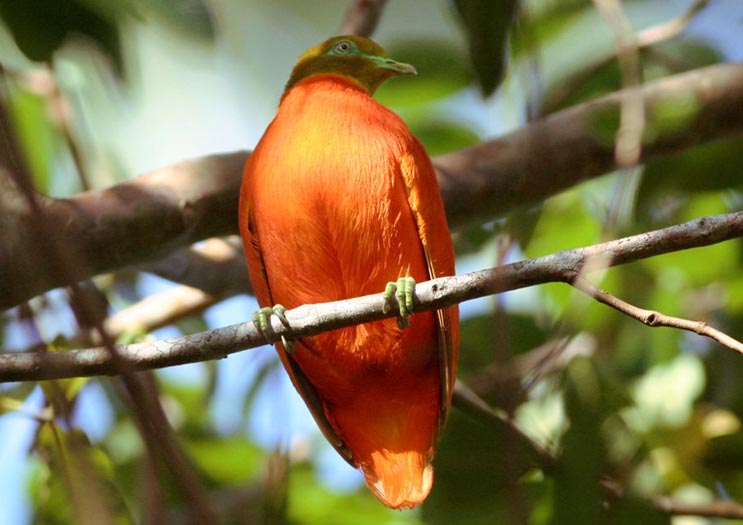 Some columbids are among the most gorgeous birds in the world, including Orange Dove of Fiji, beautifully photographed (right) by Murray Lord. It is in the genus Ptilinopus — the fruit-doves — to be discussed below.
Some columbids are among the most gorgeous birds in the world, including Orange Dove of Fiji, beautifully photographed (right) by Murray Lord. It is in the genus Ptilinopus — the fruit-doves — to be discussed below. 

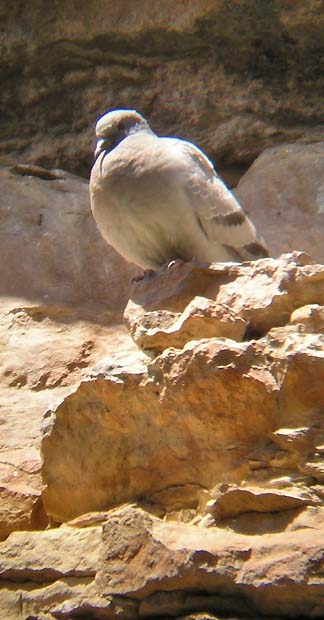
 The most widespread and abundant Columba pigeon in the world is Rock Pigeon
(left). In the wild its range included much of India, the Middle East,
and Europe. It became a common human commensal far in the past — used
as a racing pigeon, a carrier pigeon, a homing pigeon — and is now
abundant in major cities of the world. It has been bred in captivity
for eons and many human-customized varieties exist. Birds similar to
the original wild stock show glittering iridescence of pink and green
on the neck (left). Competitive homing pigeons have remarkable
navigational and flight abilities, and can average 1000 km/day at 50
km/hr. In 1986 a pigeon called "Charlie" crossed the Atlantic from
Guernsey, British Channel Islands, to Brazil, some 7588 km in distance
(Baptista et al. 1997).
The most widespread and abundant Columba pigeon in the world is Rock Pigeon
(left). In the wild its range included much of India, the Middle East,
and Europe. It became a common human commensal far in the past — used
as a racing pigeon, a carrier pigeon, a homing pigeon — and is now
abundant in major cities of the world. It has been bred in captivity
for eons and many human-customized varieties exist. Birds similar to
the original wild stock show glittering iridescence of pink and green
on the neck (left). Competitive homing pigeons have remarkable
navigational and flight abilities, and can average 1000 km/day at 50
km/hr. In 1986 a pigeon called "Charlie" crossed the Atlantic from
Guernsey, British Channel Islands, to Brazil, some 7588 km in distance
(Baptista et al. 1997). 

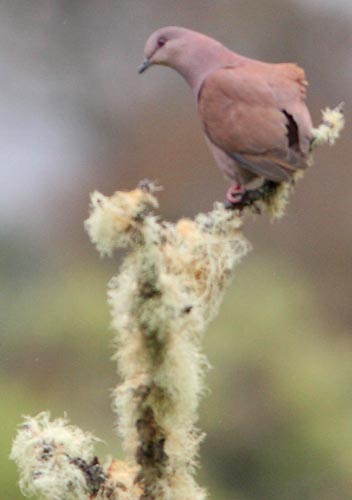


 Among the ground-doves in the remaining Gallicolumba
are five bleeding-heart pigeons in the Philippines. Each of them is
very shy and elusive; three are rated as critically endangered. During
a visit to Mindoro Island, and while staying at the warden's home in a
prison adjacent to remnant forest, prisoners brought us a snared
Mindoro Bleeding-Heart early in the morning. A leg was injured (photo
below) but it seemed to recuperate with rest and water, and later we
trekked well into the forest to release it. It flew well on release
and, in a brief stop before disappearing for good, seem to perch well.
So this shot of Mindoro Bleeding-Heart was taken in the wild (right).
Among the ground-doves in the remaining Gallicolumba
are five bleeding-heart pigeons in the Philippines. Each of them is
very shy and elusive; three are rated as critically endangered. During
a visit to Mindoro Island, and while staying at the warden's home in a
prison adjacent to remnant forest, prisoners brought us a snared
Mindoro Bleeding-Heart early in the morning. A leg was injured (photo
below) but it seemed to recuperate with rest and water, and later we
trekked well into the forest to release it. It flew well on release
and, in a brief stop before disappearing for good, seem to perch well.
So this shot of Mindoro Bleeding-Heart was taken in the wild (right). Australia
has a very impressive set of pigeons and doves, most of them within the
same set of columbids as the Old World ground-doves. Diamond Dove (pair above) is dainty, delicate, and delightful.
Australia
has a very impressive set of pigeons and doves, most of them within the
same set of columbids as the Old World ground-doves. Diamond Dove (pair above) is dainty, delicate, and delightful. 



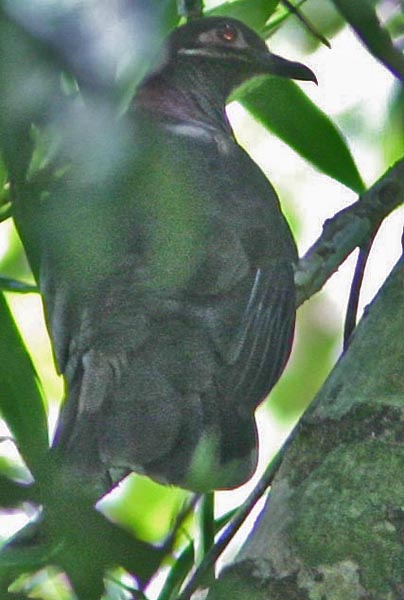
 Finally, a third of the world's pigeons are in an evolutionary subclade composed of fruit-doves (genus Ptilinopus), imperial-pigeons (genus Ducula), and related small genera, some of which have been recently merged into Ptilinopus;
Gibb & Penny (2010). Essentially 100 species are in this set of
tropical, arboreal frugivores. Some are very colorful; many are
difficult to see well in the forest interior or in the canopy.
Finally, a third of the world's pigeons are in an evolutionary subclade composed of fruit-doves (genus Ptilinopus), imperial-pigeons (genus Ducula), and related small genera, some of which have been recently merged into Ptilinopus;
Gibb & Penny (2010). Essentially 100 species are in this set of
tropical, arboreal frugivores. Some are very colorful; many are
difficult to see well in the forest interior or in the canopy. 
